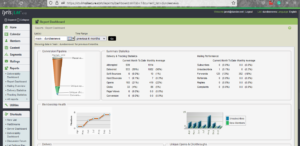Best time to send mass email campaigns or is there really a Time to Send Formula?
“When should we send our mass email campaigns?” is one of the most frequently asked questions in email marketing. Many people believe that Tuesday through Thursday mornings are generally good times to send. This answer, however, may be more complicated, and, as with most email marketing questions, the answer depends on several variables including your specific situation. To determine the best time to schedule your email delivery, you need to break the questions down into three parts
- When do you want your list members to receive your email?
- What factors determine how long it takes for your emails to reach each list member?
- Does your ESP (Email Service Provider) have the necessary resources to send emails at a regular time continuously?
Is there a formula that recommends the time to send mass email campaigns? Perhaps, here’s one that was developed on the following variables:
 Planned Open Time or POT
Planned Open Time or POT- ISP Component or IS
- Send Duration or SD
- Queue Aspect or QA
- Schedule Delivery Time or SDT
Planned Open Time – (ISP Component + Send Duration + Queue Aspect) = Scheduled Delivery Time (POT-(IS+SD+QA) = SDT). This formula serves as an example of the factors you should consider when determining the ideal timing to send mass email campaigns
Each variable can be defined as:
Planned Open Time – Even with the optimum send time, the bigger question is when will your subscribers most likely open and respond to your message. This answer is not definitive; in fact, the response will vary depending on who conducted the research.
 According to research, about 67% of emails are often opened between Tuesday and Thursday. Over 75% of these are opened between 5 am and 5 pm. It is obvious that most business-oriented email subscribers are more likely to read their emails during the workday, whereas consumer-based subscribers read their emails whenever they choose. And all time zones are consistent with this.
According to research, about 67% of emails are often opened between Tuesday and Thursday. Over 75% of these are opened between 5 am and 5 pm. It is obvious that most business-oriented email subscribers are more likely to read their emails during the workday, whereas consumer-based subscribers read their emails whenever they choose. And all time zones are consistent with this.
When your subscriber base spans the globe or varies by state, time zones may become an issue. Schedule mass email campaign segments according to crucial time zone times when a sizeable portion of your subscribers are located all over the world.
Other factors to look at, are the age, sex, and occupation of the recipient. For instance, a gaming newsletter’s readership will primarily be composed of people in their late teens and twenties, with the average age being between 16 and 18. This email group is most likely to open and read emails in the late afternoon and early evening, (assuming they are in school).
ISP Component: Not all ISPs are created equal. Some Internet Service Providers deliver emails they receive immediately, while others may take longer. Some utilize volume-based filters, so sending too many emails to a single ISP within a short time frame may cause your emails to be blocked and sent to the ISP black hole.
Send Duration: Are you mailing 6,000 emails or 6 million? The number of emails may impact the sending time, from a few seconds to many hours, depending on the technology solution, the provider you use, and the volume sent.
Queue Factor: Keep in mind when you press the send button the emails will go “in the queue” to be sent. If you schedule them on a day and time, such as Tuesday morning (when a large percentage of emails are sent) email delivery may be slow.
Schedule Time: When do you want your email to be opened? And consider that time-sensitive emails may require more planning to get delivered on time. For example, if you want a mailing of 100,000+ recipients to reach the inbox by 10:30 am the following formula
Planned Open Time 1 pm – (1 hour for the ISP to send out the email + Sending Duration adds another 1 hour+ .5 what is in the queue, dependent on how many other “marketers are mailing at the same time) = 10:30 am
Most ESP send time for 100,000 emails can take up to 1 hour- MailChimp has a graph that shows typical send times.
So, to answer the question, when is the best time to send mass email campaigns? it depends on a number of factors, but the favorites have always been Tuesday, Wednesday, and Thursday, and your competitors know too. There may be no “best time”, as this depends on your audience, where they live, age, and other attributes. Therefore, when you plan to launch a big mass email campaign, test your email over those days and times, to find the best time to send it.


Comments
Post a Comment